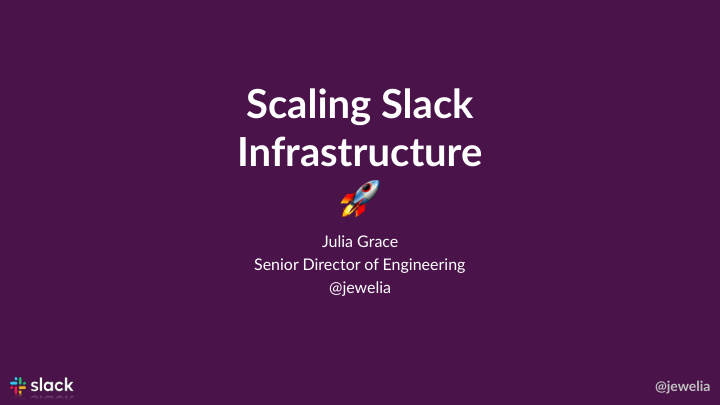



Scaling Slack Infrastructure 🚁 Julia Grace Senior Director of Engineering @jewelia @jewelia
Phase 0: 2015 @jewelia
~2.5M Daily Active Users @jewelia
Phase 1: 2016 @jewelia
~4M Daily Active Users @jewelia
Phase 1: 2016 Slack was originally designed for teams < 150ppl. You make very different architectural decisions when you’re building for a team of 100 people vs 500,000. Before August 2016 we had no Infra team. Original infrastructure built for Glitch worked very well in 2014/2015. ~150 Engineers total. Infrastructure investments would come secondary to feature work. @jewelia
Things were starting to break in strange, unusual ways. @jewelia
Phase 1: 2016 Example: User Presence Green dot indicaFng online/away/offline. Very few people noFce it, unless it’s broken (people expect it to “just work”). Apps and bots are always online. @jewelia
Phase 1: 2016 User Presence IniFally broadcast all changes to all users (e.g. “Julia Grace is away”) to the whole workspace: O(n^2). Presence was ~80% of all web socket traffic. Peak volume in late 2016: 16 million messages/minute over web socket. Presence messages: 13 million/minute. Rapidly transiFon from broadcast to publish/subscribe. @jewelia
There were many organizational challenges as well. @jewelia
Phase 1: 2016 How to build engineering-led org in a product- led company? Would we be able to get headcount, budget? How to communicate the value of we are doing to non-technical audiences? How do we interface with sales? Infrastructure as a compeFFve advantage. @jewelia
@jewelia hUps:/ /www.flickr.com/photos/pocheco/14833391966
Phase 1: 2016 Start internal evangelism on day #1. I went on an internal PR campaign: Why our work was important, why we needed to conFnually invest in infrastructure. Make work very visible to execs in other funcFons. Followed existing company process. We did planning, status reporFng, etc. at the same cadence and in the same meeFngs as product engineering. Don’t try to start a new group and invent new process. Identify executive sponsor. @jewelia
Phase 2: 2017 @jewelia
Phase 2: 2017 Technology landscape. Hack/PHP monolith on backend, JavaScript with no libraries on frontend. 1 service: presence and real-Fme messaging. Building a second service: Go caching service. These bespoke services each had to handle rate limiFng, traffic management, deployment. @jewelia
Phase 2: 2017 It was time to change our DB sharding strategy. MySQL sharded by team/workspace to Vitess sharded by various keys. Worked great! UnFl we hit scaling limits, significant hotspots. @jewelia
Monolith Service Service A B @jewelia
Monolith Service Service A B @jewelia
Monolith Who owns this? Service Service A B @jewelia
Communication Risk The more technically complex, nuanced a problem is… @jewelia
Communication Risk The more technically complex, nuanced a problem is… The higher the communication risk. @jewelia
Phase 2: 2017 Immense pressure to hire engineers. Many human SPOFs (single points of failure) because team was so small. Everyone was overextended and overcommihed. We had to figure out how to hire Infra engineers. All our hiring processes were opFmized around hiring generalists: frontend backend, iOS, Android, Ops. We skills do we need and value? How do we test for those skills? @jewelia
Phase 2: 2017 Decided to hire Infra engineering generalists. Created a take home coding exercise designed to test: 1. An understanding of servers, networking, and protocols. 2. An understanding of concurrency, performance, and resource constraints, and an ability to anFcipate future issues and implement soluFons. 3. An ability to write clear, easy to understand code, communicate your approach, and reason about tradeoffs that you have made. @jewelia
Phase 2: 2017 I wore so many hats. Too many hats. Similar to my days as a startup CTO! I was the Engineering Director and Forming strategy, hiring managers and ICs, evangelizing the org. …Product Manager and Internal interface to Product Engineering/PMs building features, externally to customers with quesFons about the integrity of our infrastructure. …Program Manager. Running cross funcFonal iniFaFves. @jewelia
Phase 3: 2018 @jewelia
Phase 3: 2018 “0 to 1” was over. Now time for “1 to ∞ ” . ReacFve to ProacFve. Transition from few teams to an org in 3 offices. Team nearly 100 engineers by end of year. Now included Data, Machine Learning, Search Infrastructure Many orders of magnitude better performance Things were not breaking all the time. @jewelia
Phase 3: 2018 Services model matured significantly. SLAs for services, consistent deployment processes, etc. Mature incident response process. Dividing into sub-teams made sense. Data Stores & Cache Infra, Service Mesh & Web Serving, Distributed Messaging. @jewelia
Phase 3: 2018 Hired Director Specialists… Had to quickly learn how to hire senior leaders whose jobs you haven’t done before. How to do this well: talk to a lot people who currently do the job you’re trying to hire for, deeply understand the talent market. and Product Managers… and did an acquisition. @jewelia
Phase 3: 2018 Challenge: coherency across a large organization. Example: overlap between Machine Learning and Frontend Infra was NULL . Difficult to have a unified vision. Stakeholders were each org were different for each part of the org; Data Infra organizaFon worked closely with G&A (finance), Search Infra did not. I should have done more re-orgs! @jewelia
2016: @jewelia
2016: 2017: @jewelia
2016: 2017: 2018: @jewelia
Today Infra has been around for ~3 years 400M async jobs processed/day to 2.5B 3M DAU (daily active users) to 10M DAU 1M simultaneously connected users to 7.5M 10 to ~100 engineers in SF, NYC, YVR Generalist (ICs, Managers) to specialists 1 amazing team @jewelia
Thank You! @jewelia
Recommend
More recommend